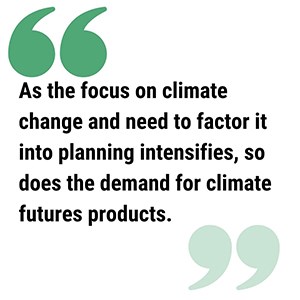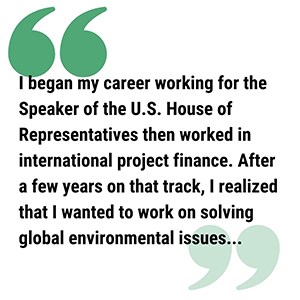Last updated: February 2, 2022
Article
Dare to Imagine: Dr. Amber Runyon

Women (and men) Lifting Women
"Over the years, Amber has provided direct, meticulous support for climate-smart management in parks like Big Bend, Devils Tower, and Wrangell-St. Elias. But the Climate Change Response Program actually depends on her expertise for every park we assist, as Amber is the technical lead for the creation of all our park-based climate trends and projections. She consistently finds new opportunities to streamline the process, increasing our capacity to serve more parks. Her ability to innovate and make essential contributions to our ongoing work deserve serious recognition!"
-Larry Perez, Communications Coordinator, Climate Change Response Program
Dr. Runyon, what project would you like to highlight?
Reproducible Climate Futures

Will you tell us a little about that project?
Due to climate change, resource managers are dealing with rapid directional change and tremendous uncertainty. Scenario planning is an important tool that The National Park Service Climate Change Response Program (CCRP) uses to help park managers move ahead with decisions that are as fully informed as possible despite climate uncertainty. A key part of scenario planning is generating a list of plausible, potential future climates that parks may expect. These ‘climate futures’ serve as the foundation of each scenario explored in the planning process because they bound the climate uncertainty. I've spent the past 5 years, with others in CCRP, developing a methodology and internal machinery for creating climate futures, however as the focus on climate change and need to factor it into planning intensifies, so does the demand for climate futures products.


What was your path like? How did you get to where you are now?
My path is different from many of my colleagues. I grew up on a West Texas cotton farm and wanted to go into a career of law and policy making. After earning a bachelor's degree in international relations and economics, I began my career working for the Speaker of the U.S. House of Representatives then, worked in international project finance. After a few years on that track, I realized that I wanted to work on solving global environmental issues so I transitioned to a non-profit evaluating the science, financial, and institutional mechanisms needed for including terrestrial carbon sequestration in carbon markets, as part of the solution to climate change. Years of that work led me to Colorado State University for a M.S and Ph.D in ecology, where I focused on climate change adaptation and water resources. During my Ph.D, I started working with CCRP as a Climate Science and Adaptation Research Assistant and formally joined the group as a Climate Change Ecologist, after finishing graduate school.

What was the hardest part about getting where you are? How did you overcome it?
Shifting from policy and finance to science was abrupt and took a lot of work to catch up to peers who had studied ecology throughout their education. Coupling the fact that I was behind in my knowledge with the imposter syndrome that is unavoidable in an academic career, created a challenging and difficult start to my career in ecology. I don't think I'll ever overcome the feeling that I don't quite fit into this field, but what helps is focusing on the strengths that my unique background and experience give me. I also love being able to work with colleagues who are supportive and I am inspired by their dedication to our mission.
What are you most proud of?
I'm proud of the mentorship that I provide the research assistants that I work with.
Favorite quote?

Related Links
Climate Change Scenario Planning Showcase
Climate Future Methodology [external link to scientific publication]
